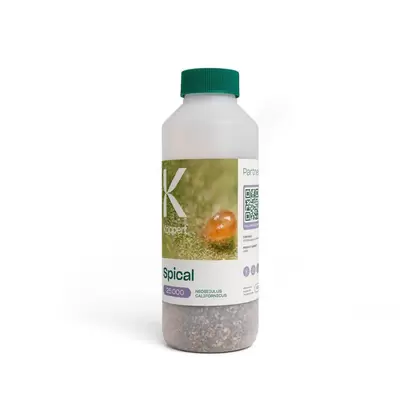Trianum-P Biological Fungicide is an innovative, preventive solution for protecting crops against soil-borne diseases. Designed to improve plant health naturally, this biological fungicide offers growers an effective, sustainable, and environmentally friendly alternative to chemical fungicides. By colonizing plant roots and stimulating natural defense mechanisms, Trianum-P helps crops resist common fungal pathogens while improving overall growth and resilience.
With versatile application methods and compatibility across a wide range of crops, Trianum-P is a must-have for greenhouse growers, hydroponic farmers, and commercial agricultural operations looking for reliable disease prevention.
Why Choose Trianum-P?
In modern agriculture, plant diseases pose a major threat to crop yields and quality. Trianum-P provides proactive protection by colonizing the root zone and preventing harmful fungi from establishing themselves. Unlike chemical treatments that only target existing infections, Trianum-P works preventively, making it an essential tool for maintaining healthy crops from the start.
Key Benefits of Trianum-P
- Prevents Soil-Borne Diseases – Protects against pathogens such as Pythium, Fusarium, and Rhizoctonia, which cause root rot and damping-off.
- Improves Root Development – Promotes stronger, healthier root systems, leading to improved water and nutrient uptake.
- Compatible with Various Growing Conditions – Thrives in temperatures ranging from 50-93.2°F and pH levels between 4-8.
- Versatile Application Methods – Can be applied through drenching, furrow spraying, potting soil incorporation, broadcast spreading, seed treatment, and chemigation.
- Works in Multiple Cultivation Media – Suitable for soil, hydroponics, greenhouse, and field applications.
- Supports Sustainable Agriculture – Reduces dependence on chemical fungicides and promotes biological crop protection.
How Trianum-P Works
Trianum-P is powered by Trichoderma harzianum, a beneficial fungus that outcompetes plant pathogens for space and nutrients in the root zone. This biological mechanism offers long-term protection against soil-borne diseases while stimulating plant defense responses.
Mode of Action:
- Root Colonization – Upon application, Trianum-P attaches to the plant’s roots, forming a protective barrier.
- Competitive Exclusion – The Trichoderma fungus prevents harmful pathogens from taking hold by outcompeting them for resources.
- Induced Systemic Resistance (ISR) – Stimulates the plant’s natural immune system, making it more resistant to disease.
- Improved Root Growth – Improves the plant’s ability to absorb nutrients and water, leading to stronger, healthier crops.
This proactive approach ensures continuous protection throughout the crop cycle, reducing the need for chemical treatments and creating a healthier growing environment.
Best Practices for Application
For optimal disease prevention, Trianum-P should be applied early in the crop cycle, ideally during:
- Sowing – For seed protection and early root colonization.
- Cutting & Transplanting – Ensures young plants develop strong roots.
- Early Growth Stages – Helps establish disease resistance before fungal pathogens can spread.
Application Methods
Trianum-P offers multiple application options, making it adaptable for various cultivation systems.
- Soil Drenching – Mix with water and apply directly to the root zone.
- Furrow Spraying – Spray directly into planting rows for field crops.
- Potting Soil Incorporation – Blend with potting media for nursery and container plants.
- Broadcast Spreading – Evenly distribute over large soil areas before planting.
- Seed Treatment – Coat seeds with Trianum-P to protect against early-stage infections.
- Chemigation & Irrigation Systems – Apply through drip systems in greenhouses and hydroponic setups.
Irrigation & Handling Precautions
To maintain the viability of Trianum-P, follow these important irrigation guidelines:
- Do Not Use Disinfectants in Drip Systems – Avoid disinfectant use for at least 1 day before and up to 2 days after application to preserve the beneficial fungus.
- Use Clean Water Sources – Ensure irrigation systems are free from excessive chlorine, peroxides, or other antimicrobial agents that could impact the effectiveness of Trianum-P.
Storage & Handling Instructions
To ensure maximum effectiveness, Trianum-P must be stored correctly and used within the recommended time frame.
Storage Guidelines
- Shelf Life – Refer to the package for the expiration date.
- Storage Temperature – Keep between 39-46°F.
- Avoid Direct Sunlight – Store in a cool, dry place away from heat sources.
Handling & Liability Considerations
- Only use in approved regions – Check local regulations to ensure Trianum-P is authorized for your crop and location.
- Follow label instructions carefully – Improper application or storage can affect the product’s quality.
- Koppert B.V. and Natural Enemies are not liable for quality issues due to improper storage or unauthorized use.
Understanding Pesticide Compatibility
Growers using Trianum-P alongside other crop protection products should be aware of potential interactions with chemical pesticides.
- Certain pesticides may impact biological solutions – Always check compatibility before application.
- Refer to the Side Effects Database – Koppert Biological Systems provides an app-based resource to help growers understand which pesticides may affect Trianum-P’s performance.
By following best practices for product handling and compatibility, growers can maximize the benefits of Trianum-P’s biological disease control.
Ideal Uses & Crop Suitability
Trianum-P is highly versatile, making it suitable for a wide variety of crops, including:
- Vegetables – Tomatoes, peppers, cucumbers, lettuce, leafy greens.
- Herbs & Medicinal Plants – Basil, mint, cannabis, lavender.
- Fruits – Strawberries, blueberries, citrus, melons.
- Greenhouse Crops – Hydroponic and soil-based cultivation.
- Ornamental & Flowering Plants – Roses, orchids, potted plants.
- Field-Grown Crops – Potatoes, root vegetables, grains.


